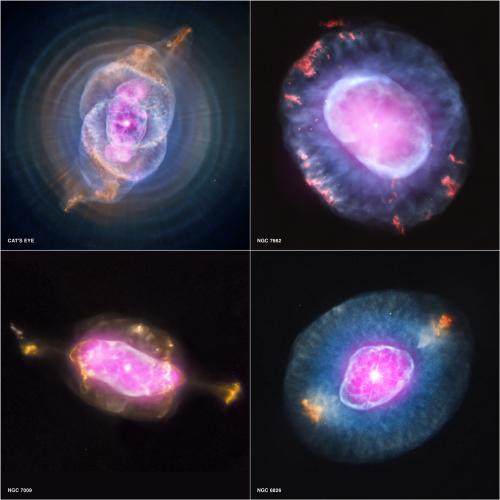It looks like you're using an Ad Blocker.
Please white-list or disable AboveTopSecret.com in your ad-blocking tool.
Thank you.
Some features of ATS will be disabled while you continue to use an ad-blocker.
6
share:

Four planetary nebulae are shown here from the first systematic survey of these dying, Sun-like stars in the solar neighborhood using the Chandra X-Ray Observatory. X-ray emission from Chandra is colored purple and optical emission from the Hubble Space Telescope is colored red, green and blue. The nebulae are NGC 6543, also known as the Cat's Eye, NGC 7662, NGC 7009 and NGC 6826. Credit: X-ray: NASA/CXC/RIT/J.Kastner et al.; Optical: NASA/STScI The death throes of dying stars are the focus of a sweeping new survey using NASA's Chandra X-ray satellite observatory.
Read more at: phys.org...
phys.org...
chandra xray satalite
ahhh the beauty of an xray universe,
A planetary nebula is a dying star (recently a "red giant") that has cast off its outer layers. The newly exposed, hot core of the star (which will eventually become a "white dwarf" star) illuminates these ejected layers, while the core's fast winds sculpt the material into a variety of shapes. The resulting dazzling objects, bearing names like Cat's Eye, Lemon Slice and Blue Snowball, are favorite targets of optical and near-infrared telescopes.
Read more at: phys.org...
ALMA
stunning images, and its like "peeling" through the dust to see the insides
A dying star weaves a spiral in the night

The number of ways stars can find to die bizarre deaths will never cease to amaze me.
Some explode, supernovae which blast radiation across the Universe. Others fade away slowly over hundreds of billions of years, longer than the cosmos has been around. Some blow off winds of gas and dust, taking on strange shapes from perfect spherical shells to elongated structures that look like two jellyfish kissing.
And then some – a very few – are like R Sculptoris, a red giant on the thin hairy edge of death. And its death is both spectacular as well as just plain old damned weird.
blogs.discovermagazine.com...
This is not a drawing! It’s actual data, observations of R Sculptoris made using the Atacama Large Millimeter/submillimeter Array (ALMA). ALMA looks at light far too low energy for our eyes to see; it’s actually out past infrared in the spectrum. Cold dust and gas emits light at this wavelength, including carbon monoxide. That molecule is created copiously in red giants and shines brightly in the submillimeter, making it easy to see with ‘scopes like ALMA. That’s nice, because CO can be used as a tracer for other, harder to detect molecules like hydrogen. Looking at CO really tells you a lot about what’s going on in the gas and dust.
the universe really is interesting in other "wavelengths"
xploder
edit on 10-10-2012 by XPLodER because: (no reason given)
edit on 10-10-2012 by XPLodER because: (no reason given)
Two thumbs way the heck up!!!!! , if for no other reason than sharing completely awsome stellar images with the rest of us.
Thanks.
Thanks.
new topics
-
WF Killer Patents & Secret Science Vol. 1 | Free Energy & Anti-Gravity Cover-Ups
General Conspiracies: 1 hours ago -
Hurt my hip; should I go see a Doctor
General Chit Chat: 2 hours ago -
Israel attacking Iran again.
Middle East Issues: 3 hours ago -
Michigan school district cancels lesson on gender identity and pronouns after backlash
Education and Media: 3 hours ago -
When an Angel gets his or her wings
Religion, Faith, And Theology: 4 hours ago -
Comparing the theology of Paul and Hebrews
Religion, Faith, And Theology: 4 hours ago -
Pentagon acknowledges secret UFO project, the Kona Blue program | Vargas Reports
Aliens and UFOs: 5 hours ago -
Boston Dynamics say Farewell to Atlas
Science & Technology: 6 hours ago -
I hate dreaming
Rant: 6 hours ago -
Man sets himself on fire outside Donald Trump trial
Mainstream News: 8 hours ago
6
